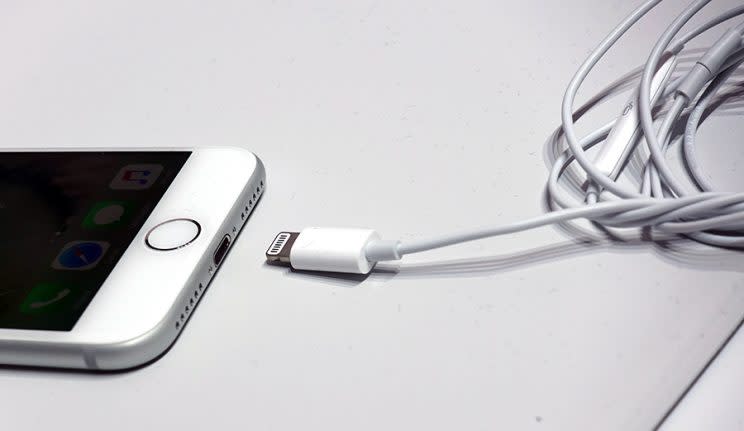Apple iPhone 7 and 7 Plus hands-on: Better, faster, stronger
Today, for the tenth consecutive year, Apple unveiled a new iPhone. This time, it’s called the iPhone 7.
After the presentation, the 500 invited journalists crammed into a hands-on room, where we got to spend about an hour with the new phones. Here’s as thorough a review as I can write after only an hour fooling with the phone. (I’ll post a more in-depth critique once I’ve had some time living with the phone in environments that aren’t white cubical rooms teeming with Apple representatives.)
The headphone jack is gone
OK, let’s get this out of the way first: It’s true. Apple is the third major smartphone maker to eliminate the traditional 3.5-millimeter headphone jack from its phone.

The primary reason is bulk. That 52-year-old technology takes up a huge amount of space inside the phone—space that could be better devoted to battery, camera, and other improved features. (You can read my more detailed analysis of this trend here.)
On the iPhone 7, you have three ways to listen to music:
Through earbuds that connect to the Lightning jack. In the box, you get new Apple earbuds that plug into the iPhone’s charging jack. And yes, that means you cannot charge your phone while listening to music (at least until someone comes out with a splitter.) And if you’re not a fan of the Apple earbuds, other companies make headphones and earbuds that plug into the Lightning jack, too.
Apple’s new EarPods with a Lighting connector.
Through an adapter that connects to the Lightning jack. In the iPhone box, you also get an adapter that accommodates any earbuds or headphones you like. (“How do I connect my earbuds to my car stereo or an in-flight entertainment system?” This is how. Just plug them in as always. Use the adapter to plug into your iPhone.) Additional adapters cost $9 each; Apple intends for you to leave them attached to your headphones.
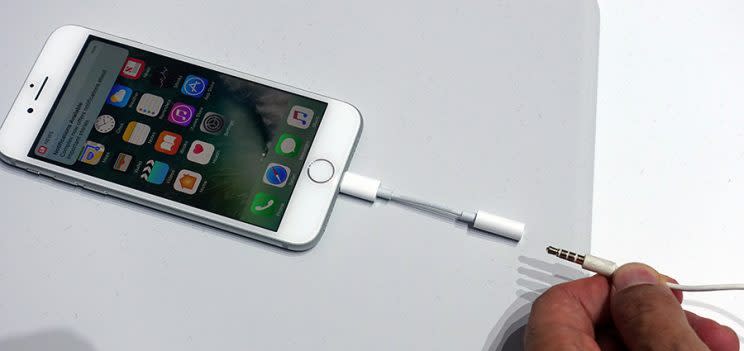
Wirelessly. Many companies now offer Bluetooth wireless headphones and earbuds. And when Bluetooth 5.0 comes out later this year—with four times the range, twice the speed, and 8 times the data throughput, plus automatic pairing—stand back. Bluetooth audio will get a whole new, much better reputation.
AirPods
Apple joined the Bluetooth party today by unveiling its own very nice, very expensive Bluetooth earbuds, called AirPods ($160, coming late October).

I tried these out for size today, too. They are, as you’d expect, far more elegant and slick than their rivals. For example, they come in a dental-floss box—I’m sorry, a white carrying case—that doubles as a recharging battery. 15 minutes in the case, and you’ve recharged the AirPods for another 3 hours of listening.
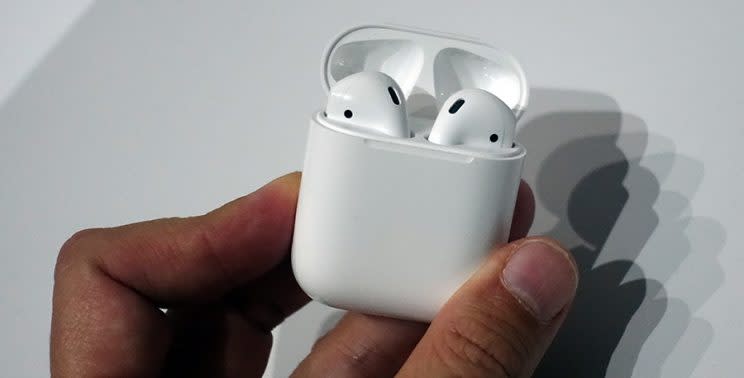
(When fully charged, the AirPods play for 5 hours—that’s 10 hours if you listen to only one at a time—and the case holds enough juice for 24 hours of listening.)
When you take one AirPod out, to answer the flight attendant, for example, your music pauses automatically—and resumes when you put it back into your ear. Very slick. A magnetic click holds the AirPods securely in the case. Tap an AirPod twice to speak to Siri. When a call comes in, your music pauses automatically, and noise cancellation kicks in so your voice is clearer.
Oh—and they sound very good, at least in a crowded talky demo room.

The AirPods are, like the earpods, really bulbous. They won’t stay in many people’s ears, especially if you’re hideously deformed like me (I’m missing the antitragus, the piece of cartilage that holds standard earbuds in place).
Fortunately, many other Bluetooth wireless earbuds are available, including two from Apple’s Beats line that have over-hear hooks and other systems that keep the earbuds on when you’re running, exercising, or standing upright.
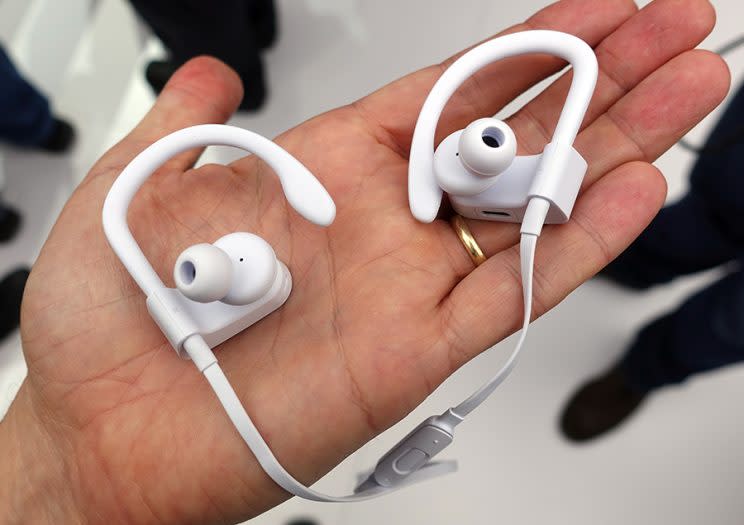
(One of my Twitter followers observed that these AirPods look like they’ll fall out and get lost very easily. Another, however, noted that if that happens to you, you can find a replacement just by looking among the leaves along the running paths of your local park.)
New cameras
Oh wow, the cameras. This is what would make me want to upgrade.
The camera on the back is now 12 megapixels, optically stabilized (so as not to blur your shot from shaky hands). The lens is f/1.8, meaning that it lets in 50 percent more light than before for improved low-light shots—a traditional iPhone weak spot. The flash is made up of 4 tiny LEDs, and is twice as bright. It’s so bright, I practically fried my corneas.
But the really big news—Apple at its best—is available only on the larger phone, the iPhone 7 Plus. This phone as two lenses on the back: One wide-angle, one telephoto (shown here at top left).
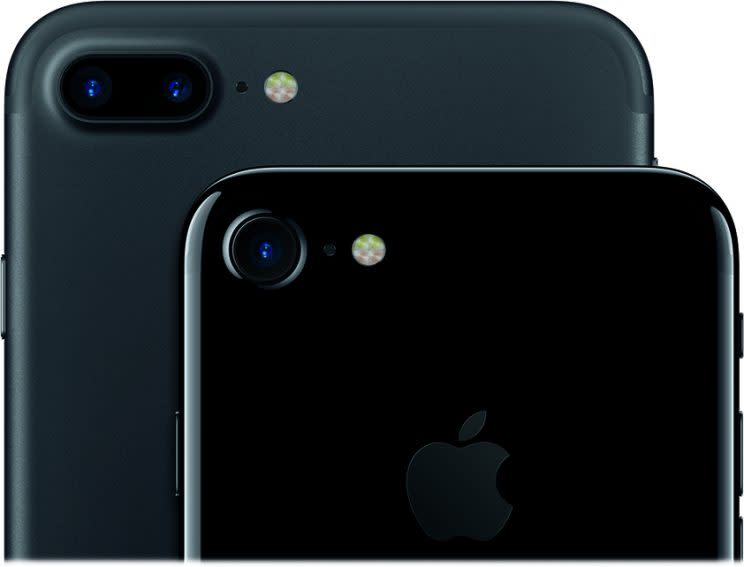
The result is that you now have actual, true, optical zoom on a smartphone. It’s only a 2X zoom (with up to 10X digital, which degrades the image some), but it’s really ingenious, and it’s hugely welcome. (Companies have tried to create optical zooms on phones before, but usually at a tremendous cost in phone thickness and bulk.)
That dual-lens business also lets the iPhone 7 Plus capture photos, using a new Portrait mode, with great-looking soft-focus backgrounds, just like you get on fancy SLR cameras. That feature won’t be available until later this fall.

The cameras are a big, big deal—big enough to count as a major attractor for potential upgraders.
The case is a new ballgame
The body of the iPhone 7 is glass (front) and aluminum, either matte (black, silver, gold, pink gold) or glistening shiny black. And one more thing: It’s now water resistant. You can’t scuba dive with it, but rain or a quick fall into the toilet is OK. (I mean phone falling in, not you.)
Apple has mucked with the Home button, too. Now, it doesn’t physically click inward when you press it. Instead, you feel a click, but it’s a fakeout—it’s a sonic, vibrational click. As a result, Apple says, the Home button is now faster to respond, more reliable, and customizable. And it’s force-sensitive, too: Apple says that it can now differentiate between a soft press and a hard press.
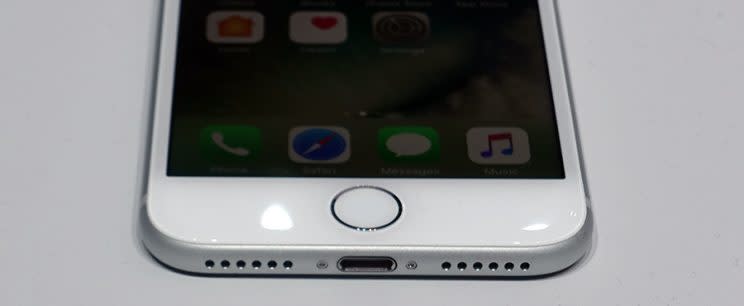
But the company didn’t say today what good that does you, and it didn’t say what “customizable” means, either. If the gods of Apple are listening, it could mean that you’ll be able to set things up so that a hard press opens the Camera app, a soft press turns on the flashlight, and so on.
Eliminating that moving part helps with the water resistance, too.
New speakers and screen
The speakers are now at the top and bottom of the phone—stereo for the first time on an iPhone. Twice as loud. They sound very good.
The screen color range has been enhanced yet again. The improvement is subtle, but we’ll take it.
The processor’s been sped up again, as always—but this time, two of its four “brains” (cores) are dedicated to computations that aren’t speed-intensive, and therefore draw less on the battery. As a result, Apple says that the iPhone 7 gets two hours more battery life per charge than the iPhone 6s, which is a blessing.
More storage for the buck
The absurdly small 16-gigabyte iPhone has, at last, been retired. Now, the iPhones 7 comes in 32, 128, and 256 gigs of storage (for $650, $750, and $850; installment and rental plans are available). For the larger 7 Plus model, the prices are $770, $870, and $970.
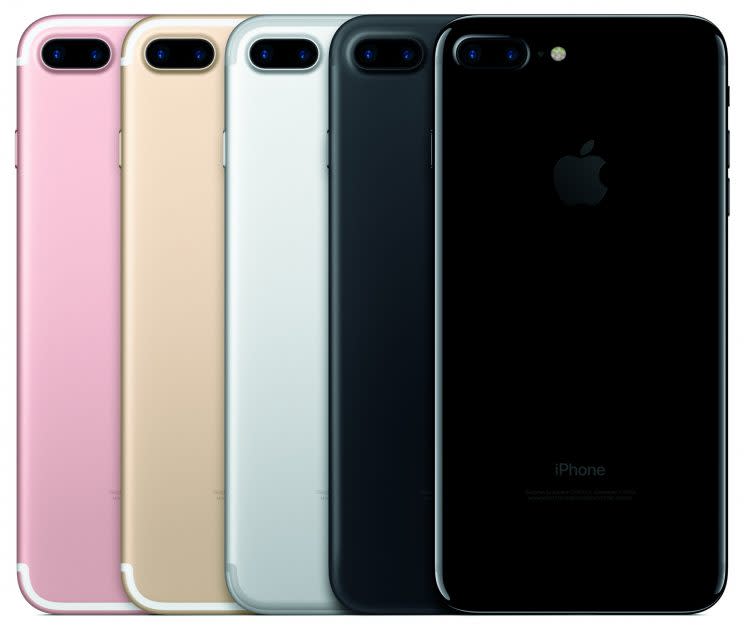
You can pre-order your iPhone 7 starting September 9; Apple will begin shipping them to customers on September 16.
The iPhone Future and Future Plus
By now, everyone recognizes that the annual cycle of adding an earth-shattering, life-changing feature to each new smartphone model is over. There’s nothing as big as an app store or Siri left to add.
So what’s left for manufacturers to add each year? Refinements. Better camera, better speed, better sound, better screen, better battery life, better software. Water resistance.
And that, in fact, is exactly what Apple has added to this year’s iPhone. Not just some of it—all of it. And within the bounds of physics and materials, that’s just about as far as a 2016 smartphone can go.
David Pogue is the founder of Yahoo Tech; here’s how to get his columns by email. On the Web, he’s davidpogue.com. On Twitter, he’s @pogue. On email, he’s [email protected]. He welcomes non-toxic comments in the Comments below.
More Apple coverage:

